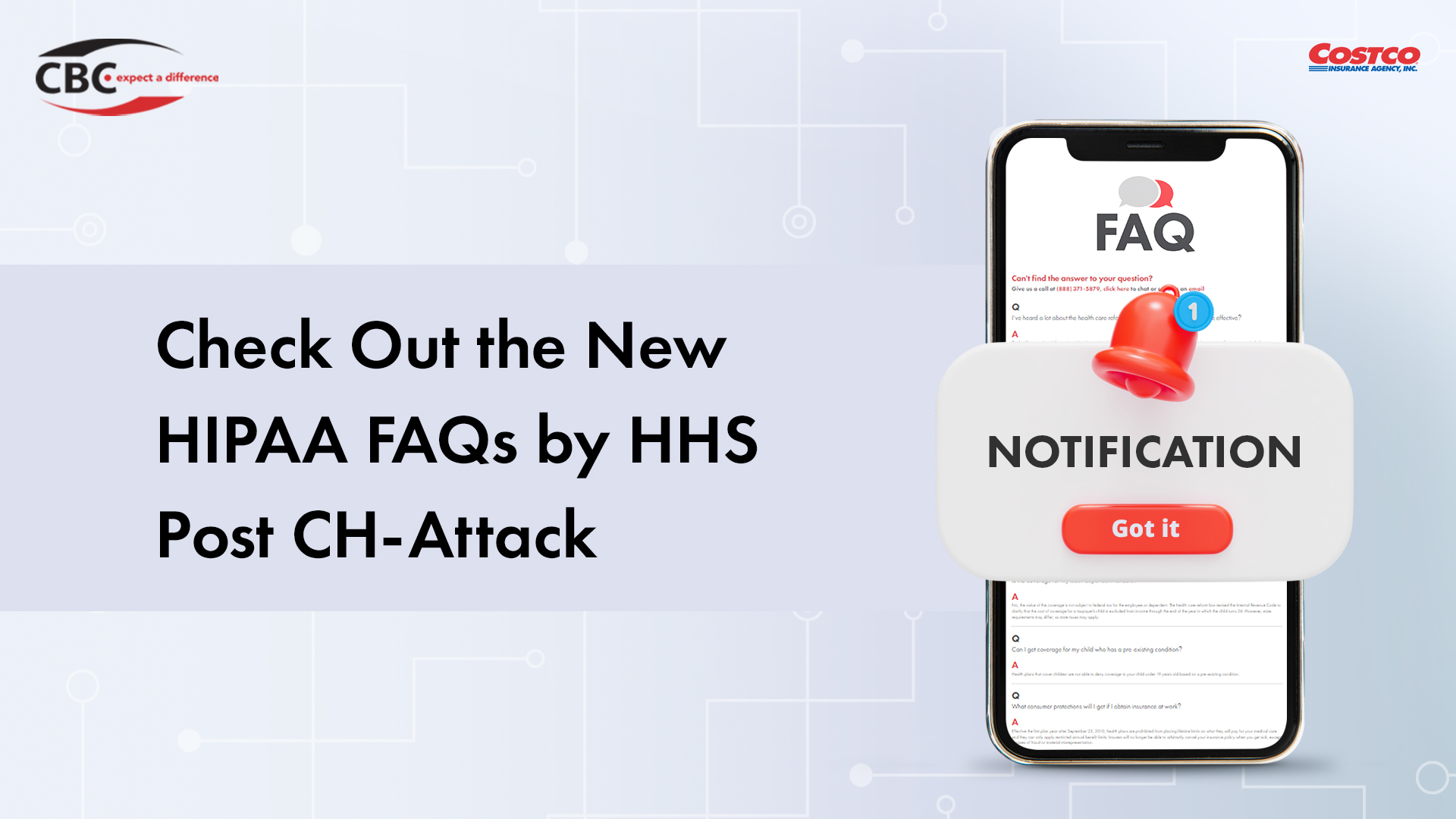Machine Readable Files
September 12, 2022

Requirement to Post Machine-readable Files Began July 1st, 2022
The Transparency in Coverage Final Rules (TiC Final Rules) require group health plans and health insurance issuers to disclose on a public website detailed pricing information in three separate machine-readable files (MRFs). Specifically, the following information must be disclosed:
- First file: In-network provider negotiated rates for covered items and services (the “In-network Rate File”);
- Second file: Historical payments to and billed charges from out-of-network providers (the “Allowed Amount File”); and
- Third file: In-network negotiated rates and historical net prices for covered prescription drugs (the “Prescription Drug File”)—this particular MRF requirement is delayed until further notice.
The files must be publicly available and accessible free of charge without any restrictions.
Action Steps
Most employers will rely on their insurance carriers and third-party administrators (TPAs) to provide the MRFs. The TiC Final Rules allow fully-insured employers to shift legal responsibility for the MRFs to their carriers if this arrangement is described in a written agreement. Self-insured employers can use their TPAs (or other service providers) for the MRFs if this is set forth in a written agreement. Still, these employers remain legally liable for compliance under the TiC Final Rules.
The TiC Final Rules suggest that self-insured employers may be required to post a link on their websites to where the MRFs are publicly available, but this is not clearly addressed in the Final Rules. Additional guidance from federal agencies on this topic would be helpful.
Employers should confirm that written agreements addressing MRFs are in place with their carriers and TPAs and that these files will be available by the applicable deadline.
Machine-readable Files (MRFs)
The In-network Rates, Allowed Amounts, and Prescription Drug Files must be disclosed as machine-readable files. The TiC Final Rules define ‘‘machine-readable file’’ as a digital representation of data or information in a file that can be imported or read by a computer system for further processing without human intervention while ensuring no lost semantic meaning. This ensures the MRF can be imported or read by a computer system without those processes resulting in alterations to the ways data and commands are presented in the file.

Open Enrollment Strategies
The Final Rules require each MRF to use a nonproprietary, open format that will be identified in technical implementation guidance—for example, JavaScript Object Notation (JSON), Extensible Markup Language (XML) or Comma Separate Value(s) (CSV). A PDF file would not meet this definition due to its proprietary nature.
A plan or issuer’s file will be acceptable so long as it:
- Includes all required data elements mandatory for the respective file (that is, all applicable rates in the In-network Rate File, allowed amounts and billed charges in the Allowed Amounts File, and negotiated rates and historical net process in the Prescription Drug File); and
- Is formatted in a manner consistent with technical implementation guidance.
Nonduplication Rule
The TiC Final Rules anticipate that plan sponsors will rely on their carriers or service providers, such as TPAs for self-insured plans, to satisfy the MRF disclosure requirements. Accordingly, the TiC Final Rules include a special rule to streamline the provision of the required disclosures and avoid unnecessary duplication. The special rule has different implications depending on the type of plan:
- Fully insured plans: A fully insured group health plan will satisfy the MRF requirements if the issuer offering the coverage is required to provide the information pursuant to a written agreement between the plan and issuer. Accordingly, if a plan sponsor and an issuer enter into a written agreement under which the issuer agrees to provide the information required and the issuer fails to provide full or timely information, then the issuer, not the plan, has violated the TiC Final Rules’ disclosure requirements.
- Self-insured plans: A self-insured group health may satisfy the MRF requirements by entering into a written agreement under which another party (such as a TPA or health care claims clearinghouse) will make public the required information. But, the plan must monitor the other party to ensure the entity is providing the required disclosures. It is ultimately the responsibility of the plan to ensure that the third party provides the required information. Unfortunately, while the TiC Final Rules suggest that plan sponsors using the nonduplication rule may be required to provide a link on their websites to the location where the MRFs are publicly available, this is unclear. Additional guidance from federal agencies on this topic would be helpful.
Content Elements for All MRFs
The following content elements are required to be included in the three MRFs:
- Name and identifier for each coverage option: Plans and issuers must include their Health Insurance Oversight System (HIOS) ID at the 14-digit product level. If the plan or issuer does not have a HIOS ID at the plan or product level, the plan or issuer must use the HIOS ID at the five-digit issuer level. If a plan or issuer does not have a HIOS ID, it must use its EIN.
- Billing codes: This includes a Current Procedural Terminology (CPT) code, a Healthcare Common Procedure Coding System (HCPCS) code, a Diagnosis Related Group (DRG), a National Drug Code (NDC) or another common payer identifier used by a plan or issuer (for example, a hospital revenue code). In the case of prescription drugs, plans may only use the NDC as the billing code type. Plain language descriptions of the billing codes must also be provided.
- In-network applicable amounts, out-of-network allowed amounts, or negotiated rates and historical net prices for prescription drugs: This will depend on the type of file (in-network amounts for the In-Network Rate File, allowed amounts and historical billed charges for the Allowed Amount File, or negotiated rates and historical net prices for the Prescription Drug File). For all MRFs, the specific pricing information within each file must be associated with the provider’s national provider identifier, tax identification number and a Place of Service Code, although the provider’s name is not required to be included. Historical payments must have a minimum of 20 entries to protect consumer privacy.
Timing: Plans and issuers must update the information required to be included in each MRF on a monthly basis to ensure it remains accurate and must clearly indicate the date the files were most recently updated.
Technical Guidance
The Departments of Labor, Health and Human Services, and the Treasury (collectively, the Departments) have been providing technical guidance for plans and issuers to assist in developing the MRFs.
GitHub Implementation Guidance
The Departments’ technical implementation guidance will be available online through GitHub, a website and cloud-based service that helps developers store and manage their code as well as track and control changes to their code. The Departments’goal in using GitHub is to facilitate a collaborative effort that allows plans and issuers to meet the public disclosure requirements of the TiC Final Rules while addressing their unique IT system, issuer and plan attributes.
To the extent a plan or issuer’s unique attributes (for example, IT system, plan benefit design or reimbursement model) are not addressed sufficiently through the technical implementation guidance, the Departments intend to provide targeted technical assistance to ensure all plans and issuers are able to meet their public disclosure requirements. The technical implementation guidance will provide instructions on obtaining this technical assistance should the need arise.
The guidance hosted on GitHub will include a file’s repository set of “schemas,” which are descriptions of how the data should be organized and arranged. Plans and issuers will be able to access the GitHub schemas at any time and collaborate with the Departments in real-time.
April 2022 Technical Guidance
On April 19, 2022, the Departments issued FAQs (FAQS About Affordable Care Act Implementation Part 53 (cms.gov) providing an enforcement safe harbor for in-network rates that are not expressed as a dollar amount:
- For contractual arrangements under which a plan or issuer agrees to pay an in-network provider a percentage of billed charges and is not able to assign a dollar amount to an item or service prior to a bill being generated, plans and issuers may report a percentage number in lieu of a dollar amount. Documentation specific to the format requirements for percentage-of-billed-charges arrangements can be found here: https://github.com/CMSgov/price-transparency-guide/tree/master/schemas/in-network-rates#negotiated-price-object
- For situations in which alternative reimbursement arrangements are not supported by the schema, or in instances where the contractual arrangement requires the submission of additional information to describe the nature of the negotiated rate, plans and issuers may disclose in an open text field a description of the formula, variables, methodology or other information necessary to understand the arrangement. Documentation specific to the use of the open text field can be found here: https://github.com/CMSgov/price-transparency-guide/tree/master/schemas/in-network-rates#negotiated-price-object
According to the Departments, they will monitor the implementation of the MRF requirements and may revisit this safe harbor in the future. In addition, this safe harbor will not apply to a particular alternative reimbursement arrangement if the Departments determine the particular arrangement can sufficiently disclose a dollar amount. The Departments encourage the continued utilization of GitHub to submit suggestions on ways the schema should support alternative reimbursement arrangements.
Source: U.S. Department of Labor.
This Benefits Insights is not intended to be exhaustive nor should any discussion or opinions be construed as professional advice. © 2008-2011, 2015, 2018 Zywave, Inc. All rights reserved.
Blog Tags:
Machine Readable Files, Transparency, Coverage, Medicare, Medicaid, health plans, MRF




